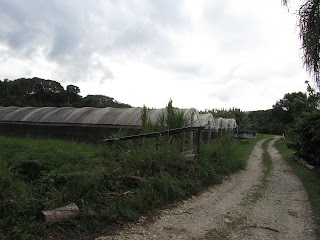
Thursday, September 27, 2012
Tour of the Trigenros Farm
The next day we said our farewells to Manaus, flew north to Boa Vista, and then drove further north to a village called Pacaraima, near the Venezuelan border. After a good night of much needed sleep, we headed out to visit the Trigenros Farm. The Trigenros (Three Generations) Farm in an organic farm nestled in a large valley in the Amazon forest. The farm is laid out to resourcefully use the natural slope of the land for irrigation and to use the tree canopies of the forest as natural shade for the same effect as a cold-frame in order to protect heat sensitive crops. The involvement of the community and the deep understanding of the natural landscape have allowed this farm to thrive on a sustainable agricultural model that is inspiring. Sustainable and organic agriculture is deeply ingrained in the Amazonian culture, and creates harmony and balance between the earth and the people.
The focus of the farm's crop yield balances the demand of the community while nurturing what the land naturally provides. For example, the orchards consists of mandarin, lime, and acai trees which naturally grow in the region. Importing crops that do not naturally originate from the region can cause potential issues with the soil composition by depleting the soil's nutrients. Contrary to my first impression of the land which appears so lush and nutritious, the farmers battle fertility issues with the soil. Only the topsoil, approximately the first 12"-18" of the soil below the surface, is fertile. Thus, the farmers focus their efforts on nurturing the native and indigenous crops produced in this region.
The farm utilizes a number of clever techniques in order to create a sustainable and organic farm in the heart of the Amazon forest. First, the farmers add viscera from animals to the compost to reduce the acidity of the soil and increase the soil's fertility and composition. In addition, crops are rotated regularly to maintain soil composition and integrity. In the cold-frames, it only take 21 days for germination and 45 days for cultivation of crops. And due to the mild climate so close to the equator, crop yields are not seasonal, but can be produced year round. Another neat factoid is that the farmers add sawdust to the animal feed in order to attract the cows into the corral for milking. Apparently cows enjoy the smell of sawdust, and the minimal amount added to the feed does not have health consequences. Plus, with the obedient cows hanging around the corral, the people from the village can come and milk the cows as they please.
Overall, I was inspired by how the farm and the community were in harmony with the earth and with each other. Just seeing how the community and culture thrived from the sustainable and organic agriculture model gave me hope, for this farm would never even consider adding GMO's and unnatural pesticides.
Subscribe to:
Post Comments (Atom)















No comments:
Post a Comment